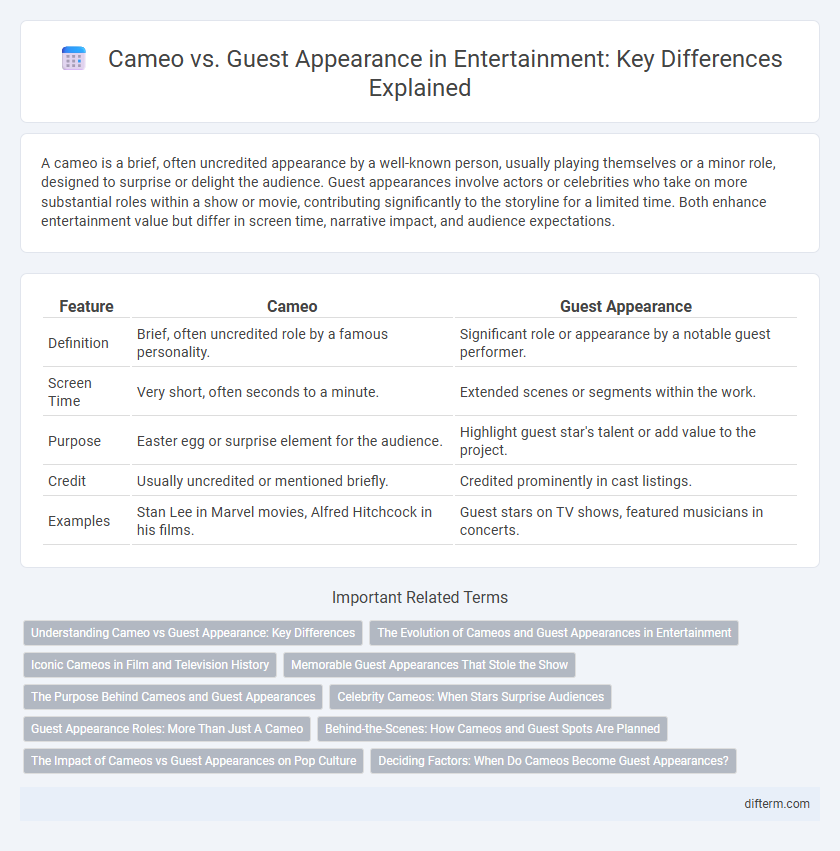A cameo is a brief, often uncredited appearance by a well-known person, usually playing themselves or a minor role, designed to surprise or delight the audience. Guest appearances involve actors or celebrities who take on more substantial roles within a show or movie, contributing significantly to the storyline for a limited time. Both enhance entertainment value but differ in screen time, narrative impact, and audience expectations.
Table of Comparison
| Feature | Cameo | Guest Appearance |
|---|---|---|
| Definition | Brief, often uncredited role by a famous personality. | Significant role or appearance by a notable guest performer. |
| Screen Time | Very short, often seconds to a minute. | Extended scenes or segments within the work. |
| Purpose | Easter egg or surprise element for the audience. | Highlight guest star's talent or add value to the project. |
| Credit | Usually uncredited or mentioned briefly. | Credited prominently in cast listings. |
| Examples | Stan Lee in Marvel movies, Alfred Hitchcock in his films. | Guest stars on TV shows, featured musicians in concerts. |
Understanding Cameo vs Guest Appearance: Key Differences
Cameo appearances typically involve brief, often surprise roles by celebrities playing themselves or minor characters, adding novelty and fan appeal without significant plot impact. Guest appearances feature actors in more substantial roles, contributing directly to the storyline and character development within an episode or series. Understanding these distinctions is crucial for industry professionals and fans analyzing narrative structure and star power influence in entertainment media.
The Evolution of Cameos and Guest Appearances in Entertainment
Cameos and guest appearances have evolved from brief, often subtle appearances by famous personalities to highly anticipated moments that enhance storytelling and fan engagement. Modern entertainment frequently leverages these appearances to create buzz, deepen narrative layers, and connect franchises through recognizable faces or characters. The integration of digital technology and social media has amplified the impact, turning even brief screen time into cultural events.
Iconic Cameos in Film and Television History
Iconic cameos in film and television history often feature legendary actors or directors making brief, memorable appearances that enhance the narrative without overshadowing the main cast. Unlike guest appearances, which typically involve characters contributing significantly to the plot across multiple scenes or episodes, cameos thrive on their surprise and novelty, creating buzz and fan engagement through their unexpected nature. Notable examples include Stan Lee's numerous cameos in the Marvel Cinematic Universe and Alfred Hitchcock's brief but memorable appearances in his own suspense films.
Memorable Guest Appearances That Stole the Show
Memorable guest appearances often leave a lasting impact by enhancing the storyline and captivating audiences with substantial screen time, unlike brief cameo roles designed for quick, surprising moments. Iconic examples include Brad Pitt's role in "Friends," where his character significantly influenced plot progression, demonstrating how guest stars can elevate a show's appeal. These standout performances contribute to both the narrative depth and fan engagement, distinguishing guest appearances as more than mere fleeting glimpses.
The Purpose Behind Cameos and Guest Appearances
Cameos serve to surprise and delight audiences by featuring brief, unexpected appearances of well-known actors or celebrities, often adding a layer of humor or meta-commentary. Guest appearances, typically longer and more integrated into the storyline, aim to enhance character development or advance plotlines through significant interactions with main characters. Both techniques enrich entertainment by leveraging familiar faces to create excitement and deepen audience engagement.
Celebrity Cameos: When Stars Surprise Audiences
Celebrity cameos captivate audiences by featuring famous stars in brief, unexpected roles that add excitement and humor to films or TV shows. Unlike guest appearances, which often involve longer, more central roles, cameos rely on the surprise and novelty of spotting a well-known personality in a fleeting moment. These brief celebrity spots generate buzz and enhance viewer engagement by blending star power with creative storytelling.
Guest Appearance Roles: More Than Just A Cameo
Guest appearance roles often involve more substantial screen time and character development compared to cameos, which are typically brief and focus on a quick, impactful presence. Celebrities in guest appearances contribute significantly to plot progression and interact meaningfully with main characters, enhancing the overall narrative. These roles provide actors an opportunity to showcase their range and leave a lasting impression beyond the fleeting excitement of a cameo.
Behind-the-Scenes: How Cameos and Guest Spots Are Planned
Behind-the-scenes planning of cameos involves discreet coordination with high-profile celebrities to create surprise elements that enhance narrative impact without overshadowing the main cast. Guest appearances require more extensive scheduling and integration into episodic storylines, often involving contractual agreements that detail screen time and character development. Production teams collaborate closely with writers and agents to ensure these roles align with both creative vision and logistical feasibility.
The Impact of Cameos vs Guest Appearances on Pop Culture
Cameos create buzz by featuring unexpected appearances of famous personalities, sparking social media reactions and fan excitement that often extend beyond the original work. Guest appearances offer deeper narrative contributions, enriching storylines and character development in television series or films, which build long-term audience engagement. Both forms significantly influence pop culture, with cameos driving momentary viral moments while guest appearances shape sustained viewer loyalty and franchise growth.
Deciding Factors: When Do Cameos Become Guest Appearances?
Cameos become guest appearances based on screen time and narrative significance, with cameos typically involving brief, often surprise appearances by well-known personalities, while guest appearances feature more substantial roles that contribute actively to the plot. The decision hinges on the character's involvement, where cameos serve as Easter eggs or nods to fans, and guest appearances are integral to story development. Audience expectations and the actor's billing also influence this distinction, as guest stars usually receive credited recognition compared to uncredited or minimally credited cameo roles.
cameo vs guest appearance Infographic

 difterm.com
difterm.com